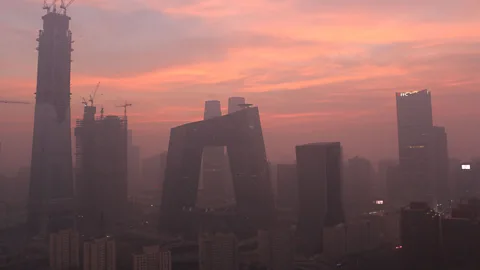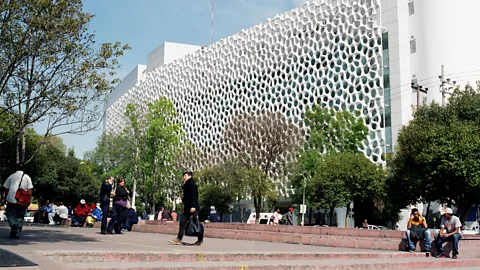How the world’s biggest cities are fighting smog
 Getty Images
Getty ImagesMore than three million people die from the effects of air pollution every year. But some increasingly high-tech solutions may soon help us all breathe more easily.
For three days in March 2016, 10 London pigeons became famous. Seeing pigeons take to the sky from Primrose Hill in north London was not unusual in itself. But these pigeons were wearing backpacks. And the backpacks were monitoring air pollution.
Once in the air, the backpacks sent live air-quality updates via tweets to the smartphones of the Londoners below. In almost all cases, the readings were not good. London’s air pollution problem has been getting worse for years, and it often rises to more than three times the European Union’s legal limit.
The pigeons and their backpacks were just the latest in a series of increasingly desperate attempts to monitor and control air pollution. According to the World Health Organisation, it is the world’s biggest environmental risk to health, and it “continues to rise at an alarming rate”. It kills over three million people every year and is especially a problem in urban areas: only one in 10 people live in a city that complies with the WHO air quality guidelines. This goes for the developed and developing world alike. Air pollution in Delhi shortens the life expectancy of its residents by 6.3 years and one in 12 deaths in London are linked to its dirty air.
Particulate matter (PM), the tiny particles emitted in vehicle exhaust fumes, are the biggest air-borne killer. One of the finest of these particles, PM2.5 – so called because it’s just 2.5 micrometers in diameter – can penetrate lung tissue and enter the blood stream, where they damage arteries and cause cardiovascular disease. Nitrogen dioxide (NO2) is the next deadliest component: by inflaming the lungs and rendering us susceptible to infection, it leads to 23,500 deaths annually in the UK alone.
And so the fight is on to eradicate air pollution in our cities. While the best solution in the long-term would be to ban fossil-fuelled cars, that won’t help the millions who are dying in the meantime, and so some high-tech solutions are now on the cards.
One of the most promising approaches can be found in Beijing, after China declared a “war against pollution” in 2014. WHO guidelines state that PM2.5 should not exceed 25 micrograms per cubic meter in any given day – but Beijing’s smog, dubbed the Airpocalypse, is regularly 10 times that level. (China’s most polluted city, Shijiazhuang, has an annual mean of 305 micrograms per metre cubed.)
 Getty Images
Getty Images“Our desire for progress has side effects and smog is one of them,” says the Dutch inventor Daan Roosegaarde, who was inspired to look for a solution after visiting Beijing in 2013. Three years later, his seven metre-high ‘Smog Free Tower’, supported by the Chinese Ministry of Environmental Protection, opened in Beijing’s 751 D Park in September 2016.
It is a giant, outdoor air purifier. In much the same way that static electricity can make loose hairs stick to a comb, airborne particles are sucked into the tower where they receive a positive charge. The particles are then captured by a negatively charged dust-removal plate and clean air is blown out of the other end.
Roosegaarde is cagey about the details – his tower was recently patented and the team is nervous about revealing too much – but he does say that charging smog particles does not take much current, meaning that the power consumption is very low. He claims it can capture and collect more than 75% of PM in an area the size of a football field, running on just 1,400 Watts – less electricity than a standard desk-top air purifier. “Some 95% of indoor air purifiers use filters, which consume a lot of electricity and need to be cleaned frequently,” he says.
Roosegaarde believes his tower could be part of the bridge between the high-polluting industrial age and the low-carbon future. “This kind of direct solution is not the permanent final solution, it is the in-between step,” he says. “We're working now on the calculation: how many towers do we actually need to place in a city like Beijing to get a pollution reduction of 20-40%? It shouldn't be thousands of towers, it should be hundreds. We can make larger versions as well, the size of buildings.”
As for what to do with the collected PM waste, he currently has a side-line selling the compacted substance as jewellery. Prince Charles owns a set of “smog free” cufflinks. If collected on at a sufficient scale, Roosegaarde believes it could even be used as a building material.
Berlin-based architect Allison Dring, director of Elegant Embellishments, has an alternative solution. Her first foray into fighting air pollution began in Mexico City in the early 2000s, when the city was fighting to shake off its unwanted reputation as the world’s most polluted city. The local PM pollutants even included “dog dust” – a large population of stray dogs and dry conditions whipped particles of dried faecal matter into the air.
Drings’s primary concern was removing the nitrogen dioxide from vehicle exhausts that also lay thick over the city. Her initial answer was to clad buildings with photo-catalytic titanium dioxide, which uses the UV from sunlight to convert nitrogen dioxide into nitric acid. The nitric acid is then immediately neutralised into a harmless salt and washed away by the rain.
 Elegant Embellishments
Elegant EmbellishmentsLooking to nature to maximise the surface area of a building façade, Dring created a coral-like design to catch light and wind from all sides. Her biggest project to-date covers 2,500 square metres of The Hospital Manuel Gea Gonzalez in southern Mexico City, reducing the pollution in the street below by the equivalent of approximately 1,000 cars per day.
Dring has since taken the architectural fight against air pollution a step further. She is now making a building material out of biochar, a charcoal-like substance made by burning agricultural crop by-product or tree clippings in a pyrolysis kiln, which chemically decomposes organic materials by heating them in the absence of oxygen. “It means that you are actually taking carbon out of the sky, converting it into a material, and then using it to build,” says Dring.
Trees do this too, taking carbon out of the air and trapping it as wood. But biochar is made from clippings and waste, and contains a lot more carbon than wood, she says. “So we're actually removing more CO2 than a tree trunk could.” What’s more, she says the biochar is “a mouldable, plastic kind of material that you can shape, which you can’t really do with wood” – making it the perfect material for architectural design.
Dring’s new building material, called Made Of Air, will make its first appearance as industrial factory cladding in Berlin in 2017. The city’s 2,000 tonnes of waste Christmas trees could provide a raw ingredient.
However, the battle for hearts and minds – to educate urban citizens of the dangers of air pollution – remains almost as hard as the science. London’s busiest shopping district Oxford Street continues to draw huge crowds, despite regularly recording annual NO2 levels that are three times the EU’s legal limit.
The hope was that the pigeon patrol would encourage Londoners to be more aware of the air they were breathing. “Pollution is invisible, so if we want to make it visible we have to find a way to grab people's attention,” says Pierre Duquesnoy at DigitasLBi, which came up with the idea in partnership with Plume Labs, the air pollution app.
 Getty Images
Getty ImagesThe tiny pollution sensors able to measure NO2 and ozone were designed by some of the scientists who had worked on the Curiosity mission to Mars. The big challenge was how to put all that on the back of a pigeon, says Duquesnoy. Racing pigeons are only strong enough to carry a load of around 40g. By 3D printing the casing, they eventually trimmed it down to a manageable size. The pigeons appeared to strike a chord with Londoners, says Duquesnoy – potentially encouraging them to take action to reduce the city’s emissions.
The fight against outdoor air pollution is really just starting. Even if none of the ideas take off, at least Prince Charles’s cufflinks, alien-looking hospital facades and pigeons wearing back-packs will have brought the issue more to the public’s attention.
Duquesnoy likens it to the healthy food craze sweeping through his native France. “People are so worried now about what they eat that they look at all the packs, turn the food upside down and read all the labels.” The more informed we are about what we eat, he says, the more interest we take in what we consume. And we consume around 8,000 litres of air every day.
Keep up to date with Future Now stories by joining our 800,000+ fans on Facebook, or follow us on Twitter, Google+, LinkedIn and Instagram
If you liked this story, sign up for the weekly bbc.com features newsletter, called “If You Only Read 6 Things This Week”. A handpicked selection of stories from BBC Future, Earth, Culture, Capital, Travel and Autos, delivered to your inbox every Friday.
